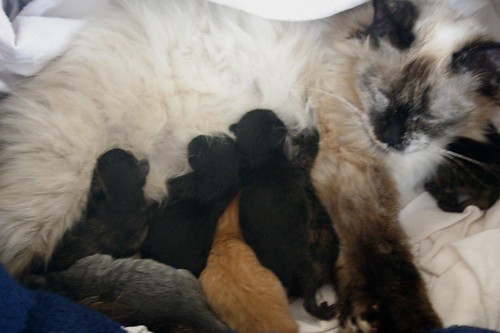Graphing Social Patterns East is on tomorrow, and I'm sorry not to be there, though m'colleague Patrick Chanezon will be. However, reading the schedule I notice the word 'viral' is still much in evidence.
If you behave like a disease, people develop an immune system
At the Facebook developer Garage last week, I heard a developer say:when I hear 'viral' applied to software I replace it with 'cancerous' to clarify. A few months back I wrote that social Apps should be Organic, not Viral, and at Google I/O last week I expanded on this with m'colleagues Vivian Li and Chris Schalk. Here's an overview of the alternative reproductive strategies to being a virus that we came up with:
r-Strategy - scatter lots of seeds
Some plants and animals, like dandelions and frogs, rely on having huge numbers of offspring, with the hope that a few of them will survive - this is known as an r strategy. In application terms this is like wildly sending out invitations, or forcing users to invite their friends before showing them useful information. It may help you spread your seed, but most of them will die off rapidly.
K-Strategy - nurture your young
Mammals take the opposite strategy; they have a few young, and nurture them carefully, expecting most of them to grow up to adulthood and reproduce themselves. This is known as a K strategy. This translates into software by following Kathy Sierra's principles to create passionate users who will share your application through word of mouth. Another way to nurture your users is to encourage them to use your application before they have to install it, as Jonathan Terleski describes.
Fruiting - delicious with a seed in
Many plants encourage their seeds to be spread more widely by wrapping them in fruit, so that animals or birds will carry them further, eating the fruit and helping the seed to propagate. The analogy here is in making sure your invitations aren't just bald come-ons for your application "a friend said something - click here to find out what" - with a forced install on the way, but instead are clearly bearing gifts to the receiving user, so they will want to click on the link after seeing what is in store. This is one of Jyri Engström's principles for Web 2.0 success with Social Objects.
Rhizomatic - grow from the roots up
Another reproductive strategy that many plants, including strawberries and ginger use is to send out runners or shoots from the roots, so that they spread out sideways, from the bottom up, known as rhizomes or stolons. The analogy here is for social applications that spread through appearing in users activity streams and via entries in application directories, growing outwards through the 'grass roots' runners that they send out as part of their normal usage.
Being dumb gets low CPMs
A lot of the debate around viral applications reminds me of a David Foster Wallace quotation:TV is not vulgar and prurient and dumb because the people who compose the audience are vulgar and dumb. Television is the way it is simply because people tend to be extremely similar in their vulgar and prurient and dumb interests and wildly different in their refined and aesthetic and noble interests.
Social networks aren't like TV - everyone sees something different in them. If you want to gather engaged, inspired, interested and indeed valued users, write an application that speaks to their refined and aesthetic and noble interests, and see how they will spread it through their social networks to find the others who share their interests.
It was interesting to see Slide redirecting away from virality today. GSP West was on at the same time and place as eTech, and I heard some eTechies refer to it as 'Grasping Social Parasites'; I hope that the growing realisation that a disease is not a good model to base your business on means that tomorrows conference will spread a better reputation for GSP East.







10 comments:
This is a very cool Analogy!
It made me think about what we're doing at IntenseDebate. I think we're about 90% "K" strategy and 10% Rhizome strategy...
In fact, if you tried IntenseDebate and liked it, the needle might move to 91%!
Thanks for the cool post!
Tom
I love metaphors, but I can't stand by when they get muddled. A virus is nothing like Cancer.
Virus reproduce themselves by infecting a host, infiltrating the host's cells with their own DNA, to generate copies, and then the reproduced 'phages' are passed from one host to another via appropriate vectors. (e.g. sneezing).
Cancer is when the individual's *own* cells go into 'runaway' (endless regenerative loops). All the cells in a cancerous tumour have the same DNA as the healthy cells of the same individual.
So... all very well to criticise the idea of 'viral marketing', but don't use the metaphor of 'cancer' to make the point, or you'll simply make the wrong point.
P.S. Kevin, I know it was something you overheard, rather than something you came up with yourself. Just being pedantic.
Rhizome is an interesting analogy but it has been overused in some circles. It's almost become a buzzword in academia. Maybe marketing can revive and expand it to include other phenomena.
That is a sweet story of social media.
Nice job. There are some great analogies in your post. I also particularly liked the David Foster Wallace quote.
Never quite thought about marketing like that before but definitely food for thought.
Great post!
Enjoyed the analogy a lot. I especially the Rhizome strategy.
Thanks for the post.
Cheers
Robin
Kevin I'm competely off topic here but if want a small but extremly exciting company to add your skills to then I would love to talk. To wet your whistle I am having build a 3 tier, 3rd generation classified social networking market place with an instant fully commercial instant micro-blogging service to feed it, if you read this please contact me you are a hard man to get hold of. anthony@lordabain.com We launch next month. Anthony
holly wood: mentioned this in @kevinmarks @nodezsh organic r....
via twitter.com
Max Temkin: mentioned this in @kevinmarks @KuraFire 👌.
via twitter.com
Post a Comment